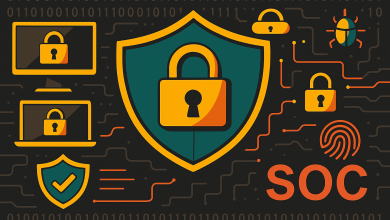
In 2024, cyber threats escalated in sophistication, frequency, and profile, with threat actors widening their scope of targets to new industries. With public infrastructure like hospitals and transportation becoming more commonly targeted, cybercrime went from being just a concern of security teams to having an impact on everyday life. Additionally, new technologies were adopted in cyber security by defenders and attackers alike, fuelling the ever-present arms race between them.
As 2025 unfolds, one thing remains the same – the cyber security landscape continues to evolve in complexity at breakneck speeds. Four dominant cybersecurity trends are shaping how organisations respond to digital threats.
AI-Generated Attacks and Deepfakes Challenge Trust
Artificial intelligence (AI) has become a favourite tool in the cybercriminal toolbox, as it allows smaller teams of threat actors to carry out increasingly complex and sophisticated attacks at scale. Technology has been increasingly leveraged by cybercriminals for social engineering, such as phishing attacks, allowing for the creation of more sophisticated and believable content. AI can also be used to create automated malware much more quickly and easily than before.
The ease of access to AI has also led to an increased use of deepfakes in low-level scams to make them more believable. Deepfakes have evolved from a niche technology to a formidable tool with immense potential, and one that should not be underestimated.
Today, deepfakes can almost flawlessly mimic both voices and visuals, creating hyper-realistic simulations that blur the line between what’s real and not. The improvement in this capability has increased enough to fool even advanced security systems, let alone employees. As deepfakes and synthetic identities rise, so will attacks targeting organisations, driving the need for new identity verification protocols and anti-fraud technologies.
With advancements in technology and sophistication, deepfakes are much more believable, and can revolutionise video content, as it will be hard to tell what a true representation is, and what was made by AI.
The Cybersecurity Skills Gap Widens
The global shortage of cybersecurity professionals remains one of the most pressing challenges for organisations. The demand for skilled cyber security professionals already outstrips supply, but if this gap grows further, there could be a critical shortfall in the coming years. Companies struggle to find skilled experts to monitor threats, investigate breaches, and secure digital assets.
In response, many enterprises respond by doubling down on automation and AI to fill gaps in threat monitoring and response. AI and automation can help find the most pressing issues or help with routine tasks. However, they need to be backed by human-led expertise to ensure they are properly trained and lack biases.
To address talent shortages, organisations rely on managed security service providers (MSPs). For many enterprises, it may make sense to hire a trusted vendor instead of staffing up their own Security Operations Centre (SOC). These vendors by working across organisations have economies of scale to keep costs down, plus greater insight into threat trends.
Ransomware Defences Are Strengthening
One notable trend in 2024 was the decreasing effectiveness of ransomware attacks. As organisations invested in proactive security strategies, the success rate of ransomware campaigns declined. This shift reflects organisations adopting a more proactive, defensive stance to secure both their own operations and third-party supply chains.
Supply chains have been, and continue to be, one of the biggest vectors for ransomware attacks to date. This decrease could also be attributed to overall awareness and improved incident response programs. Some other contributing factors could be improved network segmentation, controlling user privileges, and general improvements in data backup strategies.
A key way in which companies can help fight ransomware is through the thorough vetting of third parties. Organisations that only work with suppliers that have robust cyber security practices and programs are much better protected from third-party cyber security risks. Companies should enforce stricter requirements, including added layers of due diligence when entering partnerships with external organisations.
Cybersecurity Regulations Tighten Globally
As cyber security threats continue to grow more complex and damaging, global regulatory bodies have been stepping up enforcement to protect critical infrastructure, personal data, and the global economy. The landscape of compliance and regulatory oversight in cyber security could shift significantly in 2025, with broad implications for businesses, security practices, and the industry overall.
Enforcement could become much more aggressive, with substantial penalties for breaches or negligence. Increased legal accountability might surprise organisations, pushing them to adopt comprehensive security standards far beyond current compliance frameworks.
Currently, regulations vary significantly by region, which can be costly and confusing for global companies that operate in many different territories. We may see an effort toward harmonizing cyber security standards, especially across the EU, U.S., and parts of Asia. This would mean more uniform standards around data protection, incident response, and cross-border data flow security, although companies would still have to meet the most stringent requirements in any operating region.
Building on frameworks such as GDPR, more regions could build stronger cyber security regulations. This could include enforcing privacy rights, as well as obligating organisations to limit data collection, improve transparency, and seek explicit consent for data use. Companies may face stringent requirements to secure consumer data, notify users of breaches quickly, and demonstrate the minimum collection of personal information. Businesses must rethink their compliance strategies, ensuring they can meet rigorous security and reporting obligations across multiple jurisdictions.
Staying ahead in a shifting cyber landscape
The cyber security landscape is dynamic and continues to evolve, with AI-driven threats, workforce shortages and regulatory pressures reshaping how organisations defend against attacks. Companies that proactively adapt—through stronger authentication measures, investment in skilled talent, and rigorous compliance programs—will be best positioned to navigate the growing complexity of cyber risk in 2025 and beyond.




